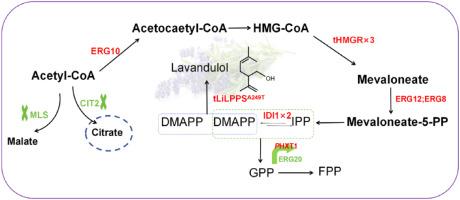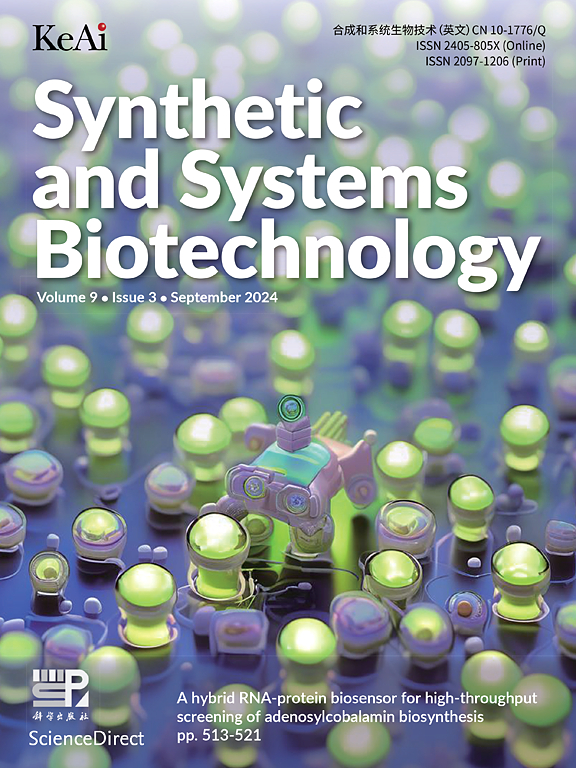Biosynthesis of irregular monoterpene lavandulol in Saccharomyces cerevisiae
IF 4.4
2区 生物学
Q1 BIOTECHNOLOGY & APPLIED MICROBIOLOGY
引用次数: 0
Abstract
Lavandulol, the primary chemical constituent of lavender essential oil, is an irregular monoterpene present in Lavandula angustifolia. It has been employed in the spice and cosmetic industries owing to its pleasing aromatic properties. In addition, its efficacy as an inhibitor of insect mating behaviour has led to incorporation within synthetic pheromone formulations. With the development of synthetic biology, more terpenoids are synthesized utilizing microorganisms. In this study, lavandulol was biosynthesized in Saccharomyces cerevisiae for the first time. An initial screening of lavandulyl diphosphate candidates was performed to identify enzymes compatible with heterologous expression in yeast. To increase the supply of DMAPP, the key enzymes of the MVA pathway, IDI1 and tHMG, as well as IDI1, ERG12, and ERG8 were overexpressed. Furthermore, the metabolic flow loss of acetyl-CoA and DMAPP was also reduced by deleting the genes of MLS1 and CIT2, as well as replacing the ERG20 promoter. Through the modification of lavandulyl diphosphate synthase, the flask titer was increased to 136.68 mg/L. Finally, the highest reported level of lavandulol production (308.92 mg/L) in S. cerevisiae was achieved by fed-batch fermentation in a 5 L bioreactor. To our knowledge, this is the first report of heterologous biosynthesis of lavandulol in S. cerevisiae.

不规则单萜薰衣草醇在酿酒酵母中的生物合成
薰衣草醇是薰衣草精油的主要化学成分,是一种存在于薰衣草中的不规则单萜。由于其令人愉悦的芳香特性,它已被用于香料和化妆品工业。此外,其作为昆虫交配行为抑制剂的功效已导致在合成信息素制剂中掺入。随着合成生物学的发展,利用微生物合成的萜类化合物越来越多。本研究首次在酿酒酵母中合成了薰衣草度洛尔。初步筛选的lavandulyl二磷酸候选人进行了鉴定酶兼容异种表达在酵母。为了增加dapp的供应,MVA通路的关键酶IDI1、tHMG以及IDI1、ERG12、ERG8均过表达。此外,通过删除MLS1和CIT2基因以及替换ERG20启动子,乙酰辅酶a和DMAPP的代谢流量损失也减少了。通过对薰衣草二磷酸合成酶的修饰,使瓶滴度提高到136.68 mg/L。最后,在5l的生物反应器中分批补料发酵,酿酒酵母的薰衣草醇产量最高(308.92 mg/L)。据我们所知,这是第一次报道在酿酒葡萄球菌中异源生物合成薰衣草醇。
本文章由计算机程序翻译,如有差异,请以英文原文为准。
求助全文
约1分钟内获得全文
求助全文
来源期刊

Synthetic and Systems Biotechnology
BIOTECHNOLOGY & APPLIED MICROBIOLOGY-
CiteScore
6.90
自引率
12.50%
发文量
90
审稿时长
67 days
期刊介绍:
Synthetic and Systems Biotechnology aims to promote the communication of original research in synthetic and systems biology, with strong emphasis on applications towards biotechnology. This journal is a quarterly peer-reviewed journal led by Editor-in-Chief Lixin Zhang. The journal publishes high-quality research; focusing on integrative approaches to enable the understanding and design of biological systems, and research to develop the application of systems and synthetic biology to natural systems. This journal will publish Articles, Short notes, Methods, Mini Reviews, Commentary and Conference reviews.
 求助内容:
求助内容: 应助结果提醒方式:
应助结果提醒方式:


